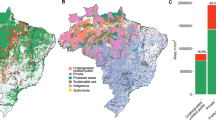Abstract
Some Pacific island societies, such as those of Easter Island and Mangareva, inadvertently contributed to their own collapse by causing massive deforestation1,2,3,4,5,6,7. Others retained forest cover and survived3,8,9. How can those fateful differences be explained? Although the answers undoubtedly involve both different cultural responses of peoples and different susceptibilities of environments, how can one determine which environmental factors predispose towards deforestation and which towards replacement of native trees with useful introduced tree species? Here we code European-contact conditions and nine environmental variables for 81 sites on 69 Pacific islands from Yap in the west to Easter in the east, and from Hawaii in the north to New Zealand in the south. We thereby detect statistical decreases in deforestation and/or forest replacement with island rainfall, elevation, area, volcanic ash fallout, Asian dust transport and makatea terrain (uplifted reef), and increases with latitude, age and isolation. Comparative analyses of deforestation therefore lend themselves to much more detailed interpretations than previously possible. These results might be relevant to similar deforestation-associated collapses (for example, Fertile Crescent, Maya and Anasazi) or the lack thereof (Japan and highland New Guinea) elsewhere in the world.
This is a preview of subscription content, access via your institution
Access options
Subscribe to this journal
Receive 51 print issues and online access
$199.00 per year
only $3.90 per issue
Buy this article
- Purchase on Springer Link
- Instant access to full article PDF
Prices may be subject to local taxes which are calculated during checkout
Similar content being viewed by others
References
Redman, C. L. Human Impact on Ancient Environments (Univ. Arizona Press, Tucson, 1999)
Kirch, P. V. On the Road of the Winds (Univ. California Press, Berkeley, 2000)
Kirch, P. V. Microcosmic histories: island perspectives on ‘global’ change. Am. Anthropologists 99, 30–42 (1997)
Flenley, J. & Bahn, P. The Enigmas of Easter Island (Oxford Univ. Press, 2002)
Webster, D. The Fall of the Ancient Maya (Thames & Hudson, London, 2002)
Betancourt, J. L. & Van Devender, T. R. Holocene vegetation in Chaco Canyon, New Mexico. Science 214, 656–658 (1981)
Mieth, A. & Bork, H.-R. Diminution and degradation of environmental resources by prehistoric land use on Poike Peninsula, Easter Island (Rapa Nui). Rapa Nui J. 17, 34–41 (2003)
Totman, C. The Green Archipelago: Forestry in Preindustrial Japan (Univ. California, Berkeley, 1989)
Haberle, S. Dating the evidence for agricultural change in the Highlands of New Guinea: the last 2000 years. Aust. Archaeol. no. 47, 1–19 (1998)
Bellwood, P. The Polynesians: Prehistory of an Island People (Thames & Hudson, London, 1987)
Spriggs, M. The Island Melanesians (Blackwell, Oxford, 1997)
Jennrich, R. Introduction to Computational Statistics: Regression Analysis, Ch. 9 (Prentice Hall, Inglewood Cliffs, New Jersey, 1995)
Brieman, L., Friedman, J., Olshen, R. & Stone, C. Classification and Regression Trees (Wadsworth, Belmont, California, 1984)
Barrau, J. Subsistence Agriculture in Melanesia (Bishop Mus. Bull. 219, Honolulu, 1958)
Austin, A. & Vitousek, P. Nutrient dynamics on a precipitation gradient in Hawai'i. Oecologia 113, 519–529 (1998)
Chadwick, O. A., Derry, A. A., Vitousek, P. M., Huebert, B. J. & Hedin, L. O. Changing sources of nutrients during four million years of ecosystem development. Nature 397, 491–497 (1999)
Ginoux, P. et al. Sources and distributions of dust aerosols simulated with the GOCART model. J. Geophys. Res. 106, 20255–20273 (2001)
Acknowledgements
We thank D. Clague, C. Field, B. Huebert, B. Keating, P. Kirch, L. Kronke, A. Kurtz, E. Landaw, G. Merchant, J. Prospero and P. Vitousek for discussions, and J. Gornbein for the statistical design and analyses.
Author information
Authors and Affiliations
Corresponding author
Ethics declarations
Competing interests
The authors declare that they have no competing financial interests.
Supplementary information
Supplementary Methods
This file describes our statistical analyses in more detail. (DOC 22 kb)
Supplementary Table S1
This table gives values of our two outcome variables, nine independent variables, and alternative values for area and isolation, for our 81 data entries. Our 69-entry set omitted islands 1–10, 29 and 30. (XLS 34 kb)
Supplementary Table S2
This table gives Spearman correlation coefficients for our 81-entry data set. (XLS 21 kb)
Supplementary Table S3
This table gives Spearman correlation coefficients for our 69-entry data set. (XLS 19 kb)
Supplementary Tables S4-6
These tables give Spearman correlation coefficients for our 81-entry and 69-entry data sets. (DOC 27 kb)
Supplementary Table S7
This table compares results of conventional multiple linear regression (minimizing squared differences between observed and model-predicted values) with results from robust linear regression (minimizing absolute unsigned differences between observed and model-predicted values). (DOC 24 kb)
Rights and permissions
About this article
Cite this article
Rolett, B., Diamond, J. Environmental predictors of pre-European deforestation on Pacific islands. Nature 431, 443–446 (2004). https://doi.org/10.1038/nature02801
Received:
Accepted:
Issue Date:
DOI: https://doi.org/10.1038/nature02801
This article is cited by
-
Undiscovered bird extinctions obscure the true magnitude of human-driven extinction waves
Nature Communications (2023)
-
Fire activity and deforestation in Remote Oceanian islands caused by anthropogenic and climate interactions
Nature Ecology & Evolution (2023)
-
A Near Four-Decade Time Series Shows the Hawaiian Islands Have Been Browning Since the 1980s
Environmental Management (2023)
-
Henceforth fishermen and hunters are to be restrained: towards a political ecology of animal usage in premodern Japan
Asian Archaeology (2023)
-
Non-native gastropods in high elevation horticultural facilities in Hawaii: a threat to native biodiversity
Biological Invasions (2019)
Comments
By submitting a comment you agree to abide by our Terms and Community Guidelines. If you find something abusive or that does not comply with our terms or guidelines please flag it as inappropriate.



